calsfoundation@cals.org
Hookworm Eradication
Hookworm disease was a significant public health issue in Arkansas until the movement to eradicate hookworms in the early twentieth century. With official estimates claiming that up to twenty percent of the entire population of the state suffered from hookworm infestation, this parasite was sufficiently widespread to affect the economy as well as the health of Arkansas. Its virtual eradication was the result of a public health and education campaign on the part of the Rockefeller Sanitary Commission between 1910 and 1914.
The hookworm is an intestinal parasite that grows and reproduces in the intestines of its hosts. When infected people deposit feces containing hookworm eggs in warm, moist, shaded soil, the eggs hatch and develop into larvae. Within five to ten days, the hookworm larvae are ready to burrow into the skin of a new host, usually between the bare toes, and then travel up through the veins into the heart and lungs. The host develops a cough that expels the hookworm from the lungs, allowing it to be swallowed. Upon arriving in the host’s intestines, the hookworm attaches itself to the lining of the intestines with its teeth, and the life cycle begins anew.
This complicated life cycle worked well for hookworms in Arkansas before the days of indoor plumbing. Sanitary arrangements often consisted of a favorite bush or open-bottomed privies that provided warm, moist shade in which hookworms could thrive. Barefoot visitors to the privies could be infected repeatedly.
The result for the human hosts is hookworm disease, a condition characterized by severe anemia. While it can sometimes lead to death, hookworm disease generally shows itself in weight loss, swollen feet and abdomens, lassitude, and a desire to eat inedible things like dirt or chalk. In children, mental and physical development can be impaired, sometimes permanently. According to the World Health Organization, some 740 million people worldwide are infected with hookworms.
In 1902, Dr. Charles W. Stiles reported to the Sanitary Conference of the American Republics that he had discovered “the germ of laziness,” describing his studies of hookworm disease. In 1909, John D. Rockefeller agreed to provide $1 million for the formation of the Rockefeller Sanitary Commission for Eradication of Hookworm Disease. Under the direction of Wicliffe Rose, the commission undertook widespread testing, treatment, and education programs in eleven states across the South, including Arkansas.
In Arkansas, it was reported that twenty percent of the population overall—and twenty-five percent of school-age children—was infected with hookworms, based on the commission’s testing of more than 50,000 people in fifty-eight Arkansas counties. The numbers varied with the geography: 61.4 percent of those tested in Izard County were infected; Nevada, Union, and Columbia counties reported sixty-six percent infection rates; and seventy-five percent of those tested in Hot Spring and Grant counties were infected. At Louann Public School in Ouachita County, according to Bob Lancaster’s The Jungles of Arkansas, every single pupil was infected.
The commission’s intensive method of combating hookworm disease combined widespread testing and treatment with door-to-door education in hygiene and an emphasis on public health efforts such as the building of hygienic privies at schools and churches and the requirement that children wear shoes to school. The Rockefeller Commission created a carnival atmosphere at their meetings, combining the testing and treatment of people with public testimonials, singing, and refreshments.
There were challenges along the way. Some Arkansans were offended by the suggestion that they might have hookworms, particularly since it had become so well known as “the germ of laziness.” Hookworm treatment was unpleasant, as it involved drinking chenopodium or thymol, both of which were poisonous to the worms, and then taking a dose of Epsom salts to remove the chemicals and the dead worms. While some were cured with a single treatment, others needed as many as five treatments, and some people simply refused to repeat the experience. Both sanitary privies and shoes for children were beyond the means of some people, especially families in which the debilitating effects of hookworm led to an inability to work.
Nonetheless, by the time the commission campaign ended in 1914, hookworm was no longer a severe problem. Not only had many sufferers been treated and cured, but public awareness had increased, with resultant changes in behavior that disrupted the hookworm’s life cycle. Complete eradication was not achieved; there are still a few cases found in Arkansas each year. However, the results were impressive. Hoyt Bleakley’s 2006 study of the economic impact of the campaign argues persuasively that literacy, agricultural output, and income all were positively affected by the near eradication of hookworm.
For additional information:
Bleakley, Hoyt. “Disease and Development: Evidence from Hookworm Eradication in the American South.” Quarterly Journal of Economics 122 (February 2007): 73–117.
Cowdrey, Albert E. This Land, This South: An Environmental History. Lexington: University Press of Kentucky, 1995.
Ettling, John. The Germ of Laziness: Rockefeller Philanthropy and Public Health in the New South. Cambridge, MA: Harvard University Press, 1981.
Fravel, Jesse. “The Arkansas Hookworm Eradication Program of 1910–1914.” Faulkner Facts and Fiddlings 12 (Winter 1970): 91–95.
———. “The Hookworm Doctor.” Rivers and Roads and Points in Between 2 (Spring 1974): 34–36.
Howard, H. H. The Control of Hookworm Disease by the Intensive Method. New York: Rockefeller Foundation, 1919.
Lancaster, Bob. The Jungles of Arkansas: A Personal History of the Wonder State. Fayetteville: University of Arkansas Press, 1989.
Rebecca Haden
Fayetteville, Arkansas
 Health and Medicine
Health and Medicine Nematodes
Nematodes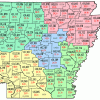 Poverty
Poverty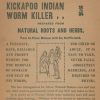 Worms [Medical Condition], Traditional Remedies
Worms [Medical Condition], Traditional Remedies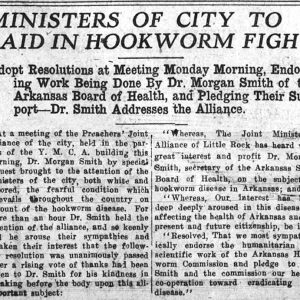 Hookworm Eradication Article
Hookworm Eradication Article 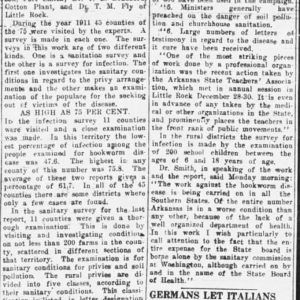 Hookworm Incidence Article
Hookworm Incidence Article 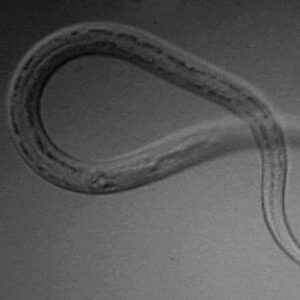 Hookworm Larva
Hookworm Larva 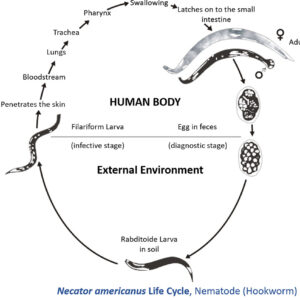 Hookworm Life Cycle
Hookworm Life Cycle 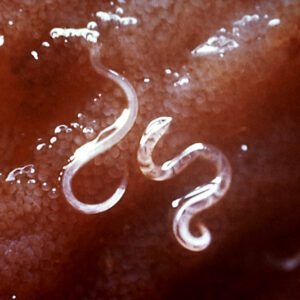 Hookworms in the Intestine
Hookworms in the Intestine 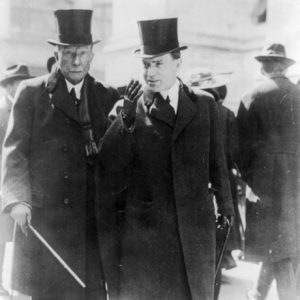 John D. Rockefeller and John D. Rockefeller Jr.
John D. Rockefeller and John D. Rockefeller Jr. 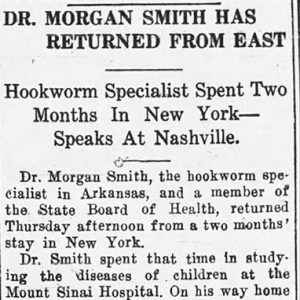 Morgan Smith Article
Morgan Smith Article 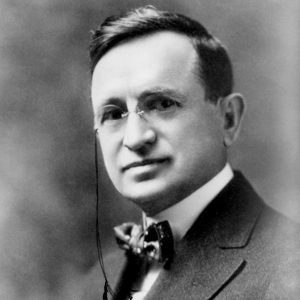 Wickliffe Rose
Wickliffe Rose 



Comments
No comments on this entry yet.